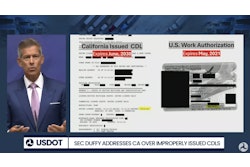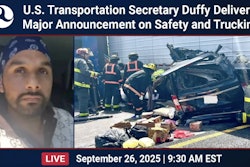U.S. Department of Transportation Secretary Sean Duffy on Friday announced what could be the most forceful DOT action around trucking in decades: A new final rule brought under what authorities called emergency circumstances to purge nearly 200,000 non-domiciled CDL holders from the industry.
During Friday's press conference, Duffy alleged numerous missteps by state driver's licensing agencies connected to a string of fatal crashes. (Read about the conference in detail via this link.)
With Trump's DOT making clear its intent to separate hundreds of thousands of operators from their non-domiciled CDLs over the next year or two, how does it all square with the "driver shortage" narrative that has so bitterly divided trucking groups?
The move comes four years after announcement of the Biden Harris Trucking Action Plan, which sought to "expedite" CDL issuance during the pandemic. Though the Action Plan didn't exactly use the "driver shortage" terminology, Raman Dhillon, CEO of the North American Punjabi Trucking Association, attended meetings at the Biden White House about the Action Plan and said the shortage narrative dominated conversations.
[Related: Rise of the 'non-domiciled CDL' for non-citizen truck drivers: Safety, rates, security]

Announcing non-domiciled CDL rule changes last week, Duffy said plainly that "we don’t need non-domiciled CDL drivers to make sure our goods flow through the country.
"We have American drivers who are ready, willing and able to take those loads."
A mainstream media outlet asked directly about the "driver shortage," with this question: "You mentioned there were plenty of Americans who want these jobs, but a number of trucking industry groups say there’s still a shortage of truckers. Do you have any concerns this crackdown might further impact the shortage of trucking drivers and the availability of goods?"
Without missing a beat, Duffy answered, "I don’t. ... I feel very good that we’re going to still move goods throughout this country and we’re going to move them safely. People are going to get their licenses legally, and when they get those licenses we want them to follow the law."
Duffy may have even gave an indication of which side of the "driver shortage" debate he comes down on -- or at least who in trucking he listens to.
"The trucking industry that I’ve spoken with know that they have a lot of capacity to pick up loads from any truckers who have licenses that are illegal, and they can transport products across the country," he said. "So no I feel very good that we’re going to be fine."
Duffy has appeared at press conferences with leadership of the Owner-Operator Independent Drivers Association, who've long argued against the "driver shortage" narrative. Duffy hasn't done anything as public with the American Trucking Associations, the organization that's most contributed to the shortage narrative with routine data updates, media appearances, testimony to Congress and plenty more through the years.
OOIDA petitioned DOT to end non-domiciled CDL issuance entirely. ATA called for an audit.
In response to the question about a "driver shortage," Duffy did offer a bit of a recruiting pitch that lines up with ATA's stated goals. "Now in the long run, do we want more young people to look at the great industry of being a trucker? Of course," he said. "You don’t have a whole bunch of college debt, you can go to school, get trained and get on the road and start making really good money right away."
Ultimately, both ATA and OOIDA came out in support of DOT's move to rid the industry of some 200,000 drivers. Duffy concluded his response to the driver shortage question with a vision of what trucking labor should look like.
"I think as you get on the road with your family ... you want to make sure they’re safe and people who drive those massive 80,000 pound rigs are well trained, well qualified, they can speak English and they got their license pursuant to the rules that are set up with FMCSA," he said.
So is the "driver shortage" narrative dead? At the very least, according to ATA, it's in retreat for now.
[Related: New research takes aim at 'driver shortage' narrative, traces roots of churn to 1980s deregulation]
ATA has stopped publishing updates on its estimate of the extent of the driver shortage, but it maintains that there is still a shortage that will likely get worse over time.
"We last calculated in 2023 that the industry was short 60,000 qualified drivers," Jeremy Kirkpatrick, ATA's director of strategic communications, told Overdrive. "We believe that number has since fallen further, as the prolonged freight recession has mitigated the shortage's impact on carriers significantly."
Since 2022, an abundance of capacity has kept rates low enough to cause many owner-operators to wonder who exactly is hauling all the cheap freight.
Kirkpatrick didn't deny that trucking's capacity to move freight is loose, and didn't fret over potentially losing 200,000 drivers.
"Given excess capacity in the market, we anticipate the industry is well positioned to meet demand in the near term," said Kirkpatrick. ATA is "still assessing the rule's impact on the trucking workforce" but thinks it actually "does reinforce the need for more qualified drivers in the U.S. over the long term."
ATA's Kirkpatrick applauded the Trump Administration for allowing 529 accounts and Pell grants for trucking careers in the One Big Beautiful Bill, and said ATA looks "forward to working with lawmakers on further investments in new career pathways into trucking, including younger Americans who represent the next generation of talent for the industry."
It seems DOT has officially recognized there are plenty drivers in the U.S. with good English and their documents in order to haul the country's freight. If there's a need for drivers in the future, Duffy and ATA seem happy to let the country's young people fill the seats.
Overdrive asked Kirkpatrick: Has ATA had ever lobbied for allowing more non-citizen drivers in the industry?
"No, that has not been a policy, priority, or goal for ATA," he said. "We have advocated for expanding career opportunities and removing barriers to entry for younger Americans, exiting military service members, and women. We also support improvements to federal job training programs, such as registered apprenticeships."
So while ATA hasn't officially given up the "driver shortage" narrative just yet, there's no longer even an estimated number. While the debate will surely rage on, for now everyone agrees there's "excess capacity" in trucking and plenty citizens ready to haul.
[Related: Spot markets signal measure of demand improvement]









